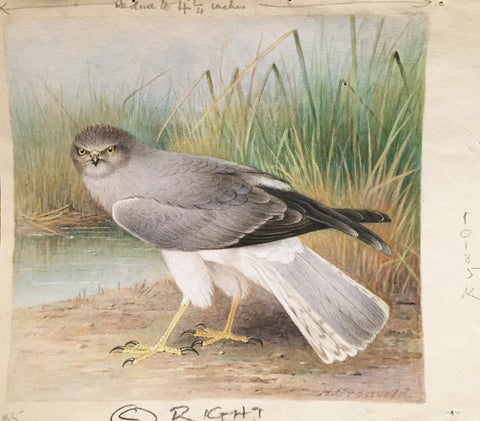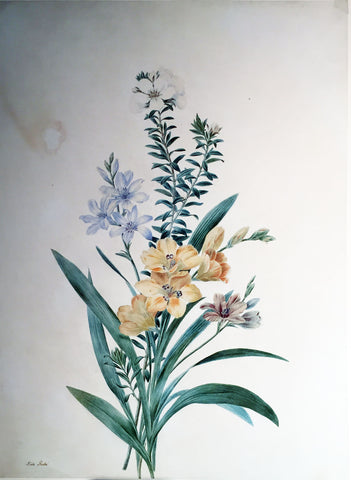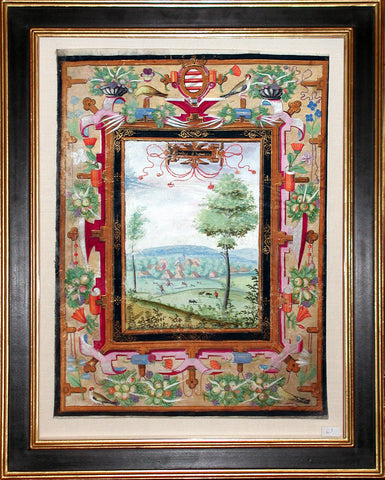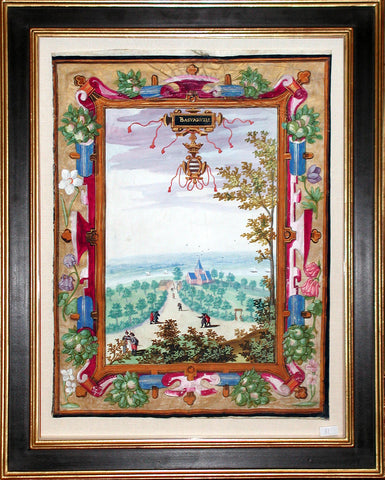
Henrik Grönvold (Danish, 1858 –1940), Circus Cyaneus (Hen Harrier)
Henrik Grönvold (Danish, 1858 –1940)
“Circus Cyaneus (Hen Harrier)”
Prepared for Plate XV W.H. Hudson and L. Gardiner, Rare, Vanishing and Lost British Birds (1923)
Pencil and watercolor heightened with gouache, some with touches of gum Arabic on paper
Signed ‘H. Gronvold’ l.r.
1922-1923
Paper size: 6 3/4 x 7 3/4 in.
Provenance: Anonymous sale; Christie’s, London, 17 March 1999, lot 149, private collector.
“In the original edition of this work, which appeared in 1894, I said: ‘That this bird is now wholly extinct in Great Britain it would scarcely be safe to affirm; one can only say that, like the preceding species (Ruff and Reeve) it is practically extinct.’ The sight of a Hen Harrier is now an extraordinarily rare occurrence, and when seen its appearance and flight render it an easy target. It became practically extinct in the last two decades of the nineteenth century and does not return to breed like the Marsh and Montagu’s Harriers.
The adult male Hen Harrier is, or was, undoubtedly the handsomest of the British Harriers. From the soft blue-grey of the plumage it has been called the Blue Hawk and Dove Hawk. The bars on the tail of the female gave it the name of Ringtail, and at one time led to the supposition that this was a distinct species. Turner (1548) writes of them as two different birds, adding however that they were alike in habits, but Willughby (1678) describes ‘The Ringtail, the male whereof is called the Henharrier.’ In figure it is more slender and airy than the other raptors, and it has a singularly buoyant and graceful flight, not unlike that of a Gull, as it beats over the ground in quest of prey, often riding so low as almost to touch the surface.
In the time when Knox wrote (1849) the Hen Harrier was, he says, far more common in Sussex than the Marsh Harrier, and he adds that examples, ‘for the most part immature, are shot or trapped every year and figure either in the game-keeper’s larder or the cabinet of the collector.’ ‘But,’ he adds, ‘all three species must be considered rare, even on the gorse-covered downs, exposed moors, and marshy commons where they once abounded.” The few birds recorded in Britain to-day are mainly immature birds wandering here when on migration, though once in a way there is a rumour of a breeding pair. Kelsall and Munn give 1893 as the date of the last nest in the New Forest, where the species was once a resident. In Wise’s New Forest it is stated to have become ‘much more numerous of late years, and no less than six or seven pairs were trapped last year.’ This method of procedure probably acted as an effectual check in Wise’s time, and the 1893 record is followed by the companion statement that two birds were killed in the Forest that year. Mr. J. H. Gurney in his Notes for 1917 says, ‘It is probable that a pair or two may still nest in Norfolk, but for some years there has been no proof of their doing so.’ In 1907 it was believed that a pair nested and were shot in Surrey. It was afterwards supposed, on the examination of the slaughtered birds by F. C. Selous, that the male bird left the place after the female was shot, and that the second victim was a young Montagu’s Harrier, this species having nested in the locality in previous years. Such details matter little. To all intents and purposes the Hen Harrier is a lost British Bird.
The loss of these extinct Hawks, and of others that are threatened with extinction, is greatly to be deplored. To say nothing of their value to us because they are what they are—parts of that harmonious and infinitely complex system which the mind contemplates with inexhaustible delight—they are necessary to the health of the system. They are, as Canon Tristram has aptly said, the ‘sanitary police of nature;’ and their action in removing the weaklings and the infected, and in keeping all creatures that are liable to be preyed on by them perpetually on the alert, is wholly beneficial, and the chief cause of that undimmed health, boundless vigour, and bright intelligence characteristic of wild animal life.
These are familiar truths, but unhappily they have been, and continue to be, disregarded by our landowners—the one class that had it in their power to preserve the bird population to the country in something like its original varied character. The desire for a large head of game, a big autumnal ‘shoot’—the ignoble ambition to transform a great estate into a kind of glorified poultry-farm, where you shoot your birds, instead of catching them in the usual way and wringing their necks—has overbalanced all other considerations. Hence the Partridge and Pheasant coddling policy, and the pitiless persecution of all birds whose presence is, or is ignorantly supposed to be, a check on the excessive multiplication of the one or two species chosen for preservation.
On the other side it may be said that the careful preservation of Partridges, and still more of Pheasants, affords protection to incalculable numbers of small birds; not only from ‘vermin,’ but also from human beings who kill birds and pull their nests down, merely for the pleasure of so doing. To those, then, who are satisfied so long as we possess an abundance of bird life, however few the species and insignificant the forms may be, the game-preserver’s action may be regarded as on the whole more beneficial than harmful. To all others this accidental benefit will not appear a thing to be grateful for, but, on the contrary, a very poor exchange. When the trees have shed their foliage we are best able to take stock of our remaining resident land species; and, excepting only the comparatively large omnipresent Rook and Wood-Pigeon, and the couple of artificially-protected and semi-domestic game birds, what species do we find in the cultivated and preserved country? The cloud of Sparrows in the rickyard; the congregations of Larks and Starlings in the fields and meadows; the swarm of mixed Finches in the stubbles and along the hedge-rows; Blackbirds and Thrushes in the woods and copses; and, overhead, the usual company of small wandering Titmice, with here and there a Robin, Wren, or Creeper—a day of terribly small things for the ornithologist! If, by chance, a Buzzard or Heron should appear, the unexpectedness of the sight, the great size by contrast of such a bird, the instant relief and change it affords from the almost hateful monotony which English bird life usually presents, excites the beholder with astonishment and delight, as if some lordly giant among the avians had been seen—an Ostrich or a Condor.
For this condition of things we have to thank the game-preserver.
So far I had written in 1894, but something remains to be added to modify, or remodel, these conclusions. Since that date a considerable change has been forced upon this country of which we do not yet see the end. We live in strange times, getting more democratic every day; and although the feeling for preserving our wild bird life—or what is left of it—has been growing apace, there have come within the last decade a social revolution. In these later days it appears likely that the game-preservers and gamekeepers, or many of them, will go with the great estates that are everywhere being reduced in size and number. The new owners of the land will be the small-holder and those of his class, who have less interest in ornithology as a science than the big landowner, and have not had time to acquire either knowledge of their own relationship with wild birds as a practical question, or the inherited sentiment which has preserved many a Rookery and Heronry. The beautiful has vanished and returns not, in so far as regards our Eagles and Harriers and Kites and Ospreys. The lesser bird-life does not come within the purposes of this book, yet it is impossible to think without some disturbed feeling of the outlook here. With the adult population, the democracy of to-day, nothing can be done. We can but say that unless an education at once more vital and were humane is given in our schools, and that quickly, those who come after us may have cause to look back to the day of small things which we owe to the game-preserver of the nineteenth century, with an even greater wonder and a more passionate regret than we ourselves look back to the days when Crane and Spoonbill and Bustard and Harrier were common sights in this country.
‘The Hen Harrier was formerly a regular summer visitor to the British Isles, a few even remaining through the winter, and it has only very recently been exterminated in the breeding- season from most parts of England. Now it is principally seen on the autumn migration, but is still said to breed occasionally in some of the wilder districts.’ —Seebohm’s British Birds.
‘Of late years its numbers have been so far thinned by game-preservers that it is now only to be found nesting on a few of the wildest and most extensive moorlands and wastes in England and Wales. Even in Scotland, where it was formerly numerous, it is rapidly decreasing as a breeding-species.’— Saunders’s Manual.
‘Twenty or thirty years ago it was known to nest in many parts of the four kingdoms. So large and conspicuous a bird could not exist where game-preservation was keen, and nowadays it is doubtful if. as a breeding species, it exists anywhere except in the Orkneys, Outer Hebrides, and perhaps Ireland.’— Coward’s British Birds.
‘The steady and persistent slaughter of these birds on the Berkshire downs and in the adjacent counties every winter must result eventually in the extermination, or at any rate serious diminution of this species in its breeding haunts in the Orkneys and Outer Hebrides, when it will probably be ascribed to quite different causes.’—F. C. R. Jourdain, British Birds (1922), XV. 211.”
HENRIK GRÖNVOLD (DANISH, 1858 –1940)
Henrik Grönvold studied drawing in Copenhagen and worked first as a draughtsman of the Royal Danish Army’s artillery and an illustrator at the Biological Research Station of Copenhagen. In 1892, Grönvold left Denmark for London, employed at the Natural History Museum preparing anatomical specimens. There he became a skilled taxidermist and established a reputation as an artist. He was employed at the Museum until 1895 when he accompanied William Ogilvie-Grant on an expedition to the Salvage Islands. After this expedition, Grönvold worked at the Museum in an unofficial capacity as an artist for decades and only left London to attend an ornithological congress in Berlin.
Grönvold’s illustrations mainly appeared in scientific periodicals such as the Proceedings and Transactions of the Zoological Society, The Ibis, and the Avicultural Magazine. In these publications, he drew plates for William Ogilvie-Grant, George Albert Boulenger, and Michael Rogers Oldfield Thomas, among others. Grönvold also completed numerous plates for Walter Rothschild, many of which appeared in Rothschild’s journal Novitates Zoologicae. Grönvold mostly illustrated birds and eggs, rare and newly discovered species from many parts of the world, and mostly worked in lithographs.
Among the books, Grönvold illustrated is George Shelley’s Birds of Africa, which contained 57 plates, many of which had not been illustrated before. He illustrated W. L. Buller’s books on the birds of New Zealand, Brabourne’s Birds of South America, Henry Eliot Howard’s The British Warblers (1907–14), Charles William Beebe’s A Monograph of the Pheasants (1918–22), and Herbert Christopher Robinson’s The Birds of the Malay Peninsula (1929–76). He completed 600 hand-colored plates for twelve volumes of The Birds of Australia (1910–27) by Gregory Macalister Mathews. Grönvold subsequently provided numerous illustrations for Mathews’ The Birds of Norfolk and Lord Howe Islands … (1928) and A Supplement to The Birds of Norfolk and Lord Howe Islands … (1936).
ORIGINAL WATERCOLORS FOR RARE, VANISHING
AND LOST BRITISH BIRDS
by Henrik Grönvold for William Henry Hudson
William Henry Hudson (1841-1922) was a naturalist, author, and staunch advocate for avian preservation and conservancy. Hudson’s lifelong commitment to protecting the environment stemmed from his youth in Argentina, where he marveled at the beauty of nature, spending endless hours watching the drama of forest and field unfold before him. This idyllic upbringing was beautifully penned in the artist’s work Far Away and Long Ago (1918), which remains a cult favorite amongst many novelists, including Ernest Hemingway, who wrote that Hudson’s book was a must-read for any young writer.
Hudson gravitated to studying birds, which guided his life’s work as an ornithologist and author of numerous tomes on the subject. When he settled in England in 1874, he joined the numerous societies for naturalists of the period and became a founding member of the Royal Society to protect birds.
In 1894, W.H. Hudson produced a leaflet titled Lost British Birds produced for Society for the Protection of Birds. Its purpose was to shed light on thirteen “lost” birds which he defined as those “which no longer breed in this country and visit our shores only as rare stragglers, or, bi-annually, in their migrations to and from their breeding areas on the continent Europe,” to concretely show the effect of industrialism, game hunting, and fashion on the sustainability of certain bird species. This pamphlet was illustrated with 15 rudimentary black and white line drawings by A.D. McCormick. Almost immediately after producing his brochure, Hudson began to collect notes for a future publication that would elaborate upon and update facts on endangered and extinct bird species.
Hudson spent the nineteen-teens and early twenties preparing his next publication. When his notes were organized, and he tapped the celebrated ornithological painter Henrik Grönvold (1858-1940) to produce a sophisticated full-color composition for each bird he intended to discuss at length. However, Hudson suddenly died in 1922 before the publication could come to fruition. Hudson’s colleague, Linda Gardiner, pushed the project forward to see it through in 1923.
Please feel free to contact us with questions by phone at 215.735.8811,
or by email at loricohen@aradergalleries.
We Also Recommend





